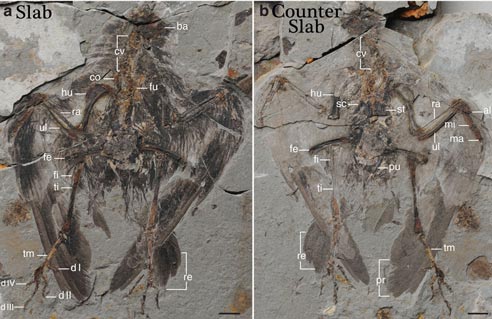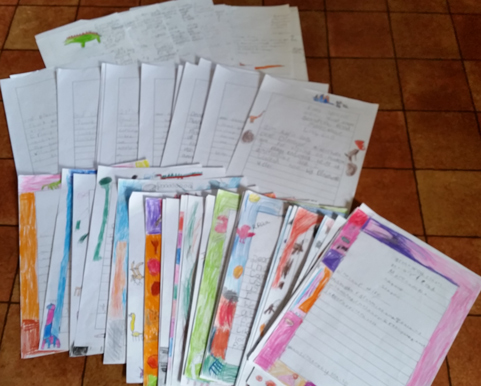Early Birds from the Early Cretaceous
Researchers from the Chinese Academy of Sciences have published information about a new species of ancient bird which suggests that the clade of Aves that produced today’s modern feathery friends, the Ornithuromorpha was around at least five million years earlier than previously thought. The new species comes from strata that is estimated to have been laid down around 130.7 million years ago (Barremian faunal stage of the Early Cretaceous). This new type of early bird, named Archaeornithura meemannae has been described from two beautifully preserved fossils (mostly, see below), discovered in the Protopteryx horizon, part of the Huajiying Formation (Sichakou basin, Fengning County, Hebei, north-eastern China).
Archaeornithura meemannae
Archaeornithura meemannae – A Very Early Bird

Archaeornithura meemannae – believed to adapted for wading.
Picture credit: Institute of Palaeontology and Palaeoanthropology (Beijing)
The picture shows an artist’s illustration of this little bird that measured around fifteen centimetres in length. The fossil has been preserved in fine-grained volcanic sediments and much of the plumage surrounding the delicate bones can still be seen. Sadly, the skull and neck bones are not well preserved in either specimen and the researchers have been unable to confirm whether this bird had teeth in its jaws or not. However, writing in the academic journal “Nature Communications”, the scientists identify this creature as the earliest known example of the Ornithuromorpha, the branch of the bird Order that led to the Neornithes (modern birds).
The previous earliest known example of a member of the Ornithuromorpha dates from rocks around 125 million years ago, this fossil too, was found in China.
The Holotype Fossil of Archaeornithura meemannae

The slab and counter slab showing the holotype.
Picture credit: Nature Communications
Early Birds
The picture above shows the slab (left) and the counter slab (right) of the holotype fossil, which like the second specimen is part of the vertebrate fossil collection at the Tianyu Museum of Nature (Shandong Province, China).
These early birds should feel very much at home at the museum, as it houses one of the most extensive collections of vertebrate fossil material excavated from Lower Cretaceous sediments in the world. The binomial name Archaeornithura meemannae comes from the Greek “Archae” for ancient and “Ornithura”, so the genus name means “ancient Ornithuromorph”. The species name honours Dr Meemann Chang in recognition of her work in the study of the Jehol Biota.
The environment of this part of north-eastern China during the Early Cretaceous was one of a sub-tropical climate, dominated by extensive forests interspersed by numerous large bodies of fresh water. The absence of feathers on the legs of A. meemannae and the long legs has led to speculation that this bird may have lived in a lacustrine habitat and been adapted to a wading life-style.
Little is known about the skull, so the diet can only be guessed at, but perhaps this ancient bird ate insects or pecked at water plants. Although the research team cannot be certain, it has been stated that this early bird was not that interested in catching worms, as the proverb goes, but it probably was a herbivore.
Ancient Bird
The Remarkably Well-Preserved Plumage (Wings)

A close up of the feathers on the wings.
Picture credit: Nature Communications
The picture above shows:
a). Left wing main slab holotype
b). Right wing main slab holotype
c). Feathers on the remnants of the head and neck
d). Alular feathers on the left digits with one very clearly visible wing claw.
Feather Adaptations
Alular feathers are found on the leading edge of the wings of birds (they are also associated with the limbs of some feathered dinosaurs, we think). They help direct air over the upper surface of the wing, thus improving control and lift. More primitive birds such as the confuciusornithids lack these feather adaptations. Ornithuromorpha are believed to have comprised about half of the bird species that lived during the Mesozoic, the descendants of some of these birds from the Ornithuromorpha clade survived the Cretaceous mass extinction and evolved into modern birds.
The other major bird clade of the Mesozoic Era was the Enantiornithes, although common, this group died out and are not directly ancestral to modern birds.
Co-author of the study Wang Min (Chinese Academy of Sciences) stated:
“The new fossil represents the oldest record of Ornithuromorpha. It pushed back the origination date of the Ornithuromorpha by at least five million years.”
To the casual observer, if you had travelled back in time to view Archaeornithura meemannae, it would have looked very similar to modern wading birds, except for the small claws visible on its wings.
The Chinese scientists conclude that by around 130 million years ago a number of avian lineages had already evolved and that it was quite likely that the Aves rapidly diversified during the early part of their evolutionary history.
PNSO have included models of several feathered theropods in their “Age of Dinosaurs” replica range: PNSO Age of Dinosaurs Models.






